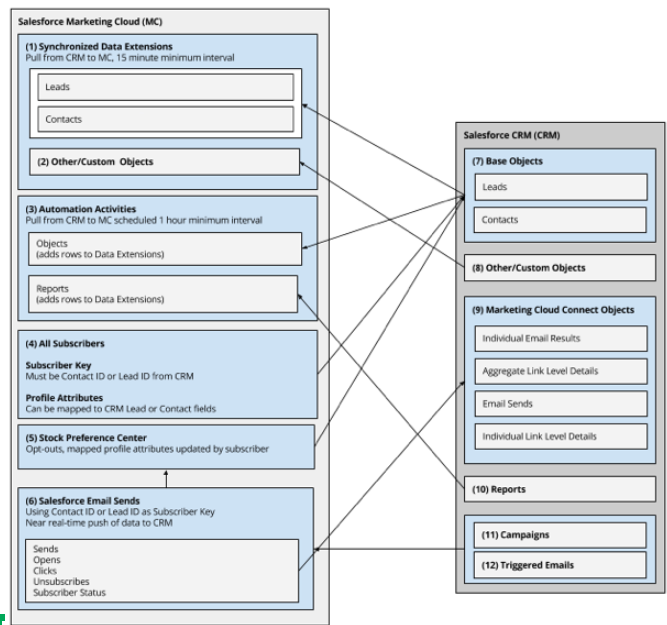Standard administration and connectivity in Salesforce Marketing Cloud: The role of the Admin

In our ecosystem there is an essential component which is the Salesforce Administrator. However, the role this profile plays does not apply in the same way to Salesforce Marketing Cloud (SFMC), because it is a very different platform to the others of the environment.
For the most CRM technological platforms, the administrator is a role restricted to giving support and attending end users requirements. On the contrary, the responsibilities and tasks of the Marketing Cloud administrator can be much more relevant depending on the size of the organization.
The role of the Administrator in SFMC
In small organizations or small teams where the use of Marketing Cloud stands out, the administrator role can also include developing the strategy for the use of the platform’s automated tools. Therefore this role is no longer just an administrator, because it turns into a consultant of some kind for all the organization. Thus, this professional may have to promote changes in the way data is collected in the CRM and other sources of gathering information, to be able to use it to customize communications.
You have to think about the full contactability objective, because it is not only about sending promotional emails. B2C has changed and now it is expected to be relevant and customizable.
Fostering the constant improvement of business intelligence is key when testing campaigns and collecting analytics. In this matter, one of the best tools is automation. The scalability of every project must be aligned with this kind of processes which also allow the solving of another of the functions to be covered by the platform administrator: support and attend end user requirements.
It is important to understand that in order to properly use the Salesforce Marketing Cloud, and all the Marketing Automation tools, all of the above must be covered by one or more profiles within the same marketing organization or team.
To be a Marketing Cloud Administrator may also require a constant development of the platform’s functionalities, towards other front-end business tools, the use of which will give us a better and more extensive contactability platform.

Standard connectivity in Salesforce Marketing Cloud
With this in mind, we will now address the main ways to connect Marketing Cloud from a not-so-technical perspective. First of all, it is important to understand why we integrate SFMC with other platforms. Generally speaking, there are two reasons:
- Functionality: to expand the functionality with other native apps or platforms that allow increasing usability of the products. For example, long before Salesforce fostered the use of WhatsApp for case generation in Service Cloud, many consulting teams used intermediate server applications to connect and enable WhatsApp as a contactability inbound/outbound channel in every Salesforce platform, including their Marketing Cloud journeys.
- Data: data collection, even some cases in real time like those that come from an event like an ecommerce company, for example, allow you to aim messages in a relevant way, with a customized content.
Regarding interactions, these are their main types:
Salesforce CORE – SFMC Connector: As is well known, Marketing Cloud was a platform purchased by Salesforce called Exact Target. Having been built outside the Salesforce programming language and its platform, the easiest way to make it work correctly with other products is to generate a connector. Connectors are a type of integration, but not every integration is a connector. What distinguishes them is that they already come preconfigured in the treatment of their data model between both platforms, and they are also very easy to configure, compared with when we have to develop an integration.
In the following infographic you can see the mapping between them:

API SOAP/REST integrations: Marketing Cloud is equipped to use both SOAP and REST protocols, each one with their own limitations and specific reasons to be used. Without going into the details, SOAP is used only for the Email Marketing application, while REST is much more flexible and is used in other cases with different tools from the Marketing Automation platform.
In addition, SFMC has its own tools that allow it to increase its functionality and modify data, which are part of its common use among these:
Cloud Pages: a tool capable of creating static websites which can be embedded in another website but using data and customization of your Salesforce CRM or from Marketing Cloud itself. It has a very versatile web editor and, through AMPscript, you can get the right touch of customization.
Web-Collect: Mainly used to create preference centers and make opt-in and opt-out, it allows our subscribers to interact with the data we store with it, update it or even delete it.
FPT of SFMC: Each SFMC instance has its own FTP, this tool allows you to upload / download files from external sources to be processed in Marketing Cloud or another source. Its use cases are countless and it is a very versatile tool when we want to unify data at low cost.
All of the above is only part of the Marketing Cloud Administrator’s life. It is not necessary for a single person to know how to do everything, but it is important to know the main tools to nurture this platform and make the end goal a reality.
If you like challenges, it’s time for you to start your Salesforce training. Trailhead is a good place to get acquainted, and if you think you need to be directed and accelerate your knowledge quickly, ISDI CRM is the ideal business school.
Did you find this article interesting? Share it!
Maybe your friends will also enjoy this.




